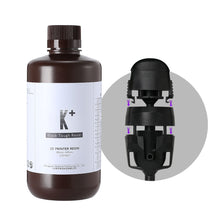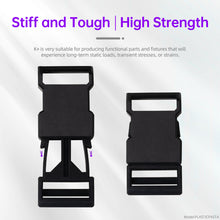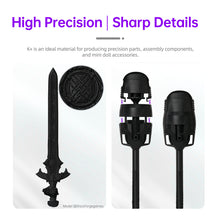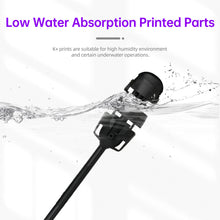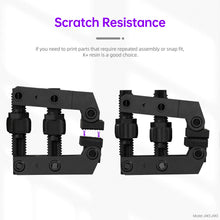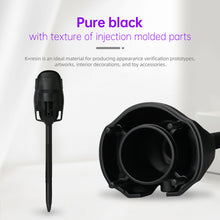
Click here to download the settings
K+ has undergone a formula upgrade based on K resin, making it an ideal material for producing functional parts or assemblies. K+ and K printed parts have similar physical properties—High stiffness and toughness, extremely high dimensional and detail accuracy. However, K+ has lower water absorption and better scratch resistance compared to K, which makes K+ more widely used, such as for parts operating in high humidity environments or components that require repeated disassembly and assembly. In addition, the K+ printed parts are pure black and will not appear blue purple in sunlight, with a texture and mechanical properties similar to those of injection molded parts.
▌ Reviews
▌ Attention
- K+ resin liquid has a special odor
- Excessive post-curing or low temperature will make prints brittle
- Do not apply too much force to the prints just after post-curing, it will take several hours for the prints to reach the mechanical properties they should have
▌ The difference between K+and K
- K+ resin has some special odors compared to K
- The K+ prints are pure black, while the K prints will show a deep blue purple color in sunlight
- The water absorption of K+ printed parts is lower than that of K
- K+ is scratch resistant, while K is not scratch resistant
▌ Descriptions
- Stiff and Tough, High Strength
- High Precision, Sharp Details
- Low Water Absorption Printed Parts
- Scratch Resistance
The surface of K+ printed parts is hard, with excellent scratch resistance performance. The surface of the parts will not be easily scratched by hard objects or powdery by friction. If you need to print parts that require repeated assembly or snap fit, this resin is a good choice.
- Pure black, with a texture similar to that of injection molded parts
K+ resin is a pure black liquid, and printed parts will not appear blue purple in sunlight like K resin. It has a delicate texture similar to injection molded parts, the appearance is high-end and good-looking. It is an ideal material for producing appearance verification prototypes, artworks, interior decorations, and toy accessories.
▌ Print Settings
- Operating Temp: 20~35℃/68~95℉
- Layer Height: 0.05mm
- Exposure Time: 3.3~5s
- Bottom Exposure Time: 50~70s
- Lifting Height:
LCD Screen size less than 8.9 inches: 6mm
LCD Screen size ≥8.9 inches: ≥9mm - Rest Time After Retract/Off times /Light-off Delay: ≥2s
- "Anti-aliasing"/"Grayscale" remains OFF!
▌ Cleaning and Post-curing
- Cleaning time: ≤5mins
- Cleaning solvent: 95% Ethanol or IPA
- Post-curing light source: 385-405nm UV(40W)
- Post-curing time: 10min
▌ Compatible 3D Printer
-
All series of Anycubic,Elegoo,Nova3d,Peopoly,Phrozen,Epax,Creality,Zortrax, BIQU, QIDI, UNIZ, Flashforge, Voxelab, Longer, Uniformation etc. UV 395-410nm LCD resin 3D printer
-
All series of Anycubic,Asiga, Elegoo, Solus series, Miicraft, Kudo3d, Flashforge,Makex,Shining etc. UV 385-410nm DLP resin 3D printer
▌ Mechanical Properties
| METHOD | DATA | |
| Shore Hardness | ASTM: D2240-05 | 85D |
| Tensile Strength | ASTM: D638-14 | 38MPa |
| Tensile Modulus |
ASTM: D638-14 | 610MPa |
| Flexural Strength | ASTM: D790-10 | 62MPa |
| Flexural Modulus | ASTM: D790-10 | 1.5GPa |
| Notched IZOD | ASTM: D256-10 | 22J/m |
| Elongation at Break | ASTM: D638-14 | 21% |
| Water Absorption | ASTM: D570 | 0.65% |
| Viscosity(25℃) | ASTM: D4212-10 | 288mpa.s |






